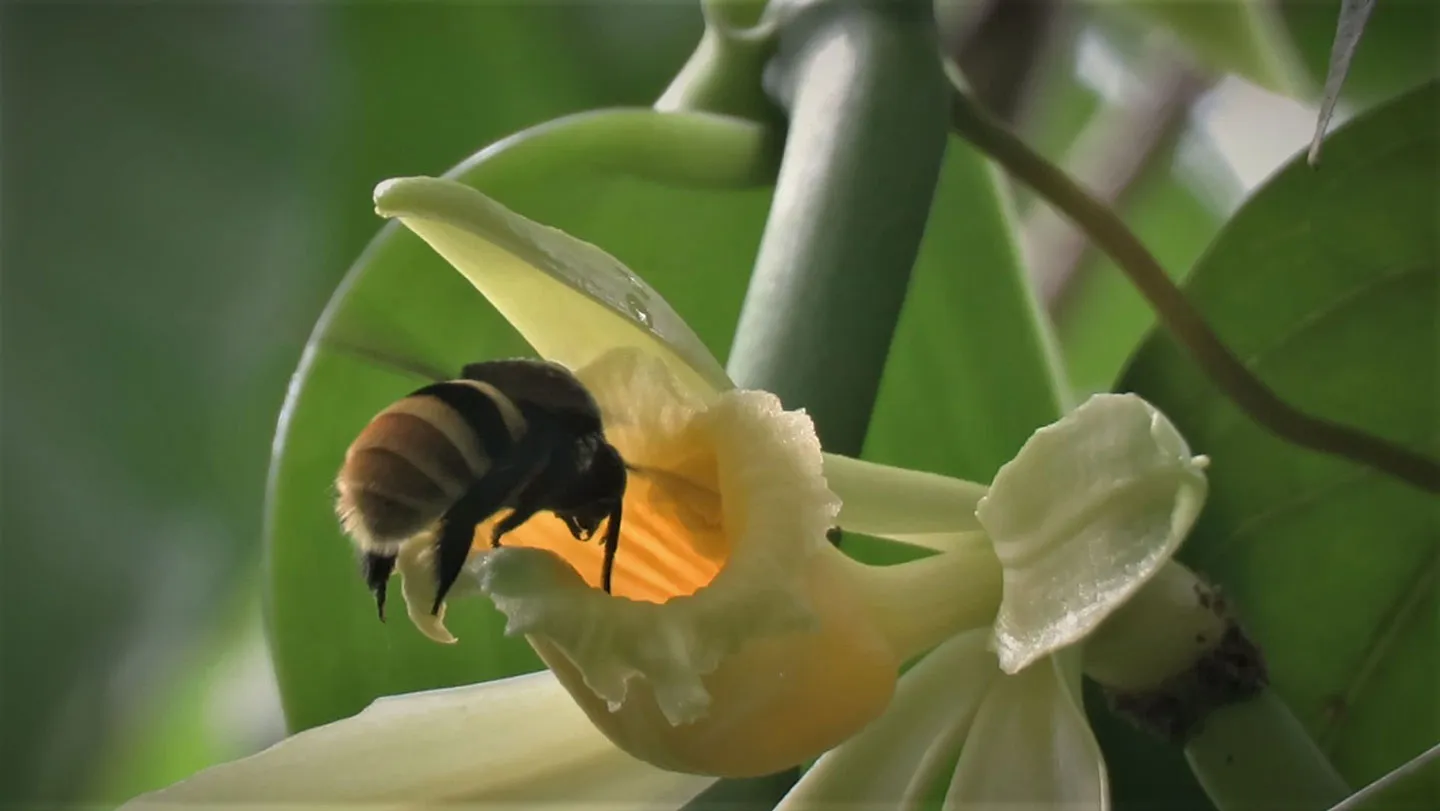Climate Change Threatens Vanilla’s Delicate Bond With Its Pollinators
New research warns that climate change may disrupt the fragile ecological relationship between vanilla orchids and their natural pollinators—jeopardizing global vanilla production and the livelihoods of farmers who rely on it.
Vanilla, one of the world’s most cherished and expensive spices, owes its existence to an intricate and fragile relationship between orchid plants and their specialized pollinators. But this relationship—already tenuous in much of the world—may soon be pushed to a breaking point by climate change. A new study published in *Nature Ecology & Evolution* reveals that rising global temperatures and erratic rainfall patterns could spatially and temporally disconnect vanilla orchids from the wild pollinators they rely on, threatening both biodiversity and the global vanilla industry.
Vanilla’s Unusual Biology
Vanilla comes from the *Vanilla planifolia* orchid, a vine native to the tropical forests of Mexico. Unlike many other crops, vanilla flowers are naturally pollinated by only a small group of insects—primarily Melipona bees, native stingless bees that are adapted to navigate the orchid’s uniquely structured blossoms. These pollinators are rare, habitat-specific, and deeply sensitive to climate changes.
What makes this relationship especially vulnerable is timing: vanilla flowers bloom for only a single day. If pollinators aren’t present at exactly the right time—on the right day, in the right hour—no pollination occurs. As the climate changes, flowering times may shift, and the availability of native pollinators may not keep up.
The Pollination Crisis in Numbers
Over 80% of global vanilla production now comes from hand-pollinated crops, especially in countries like Madagascar, Indonesia, and Uganda, where *V. planifolia* has been introduced but where its native pollinators do not exist. In these regions, human labor replaces what bees once did naturally.
Farmers wake early to manually pollinate each flower by hand using a tiny stick or blade of grass. But even in native regions like Mexico, where wild pollinators still persist, researchers say climate change may alter the geographic overlap between vanilla orchids and Melipona bees. “We’re observing a phenomenon known as ecological mismatch,” explained Dr.
Reena Solano, an ecologist at the National Autonomous University of Mexico and lead author of the study. “It means the plant and its pollinator may no longer be in the same place at the same time. ”
Climate Change and Shifting Niches
Using climate modeling, the researchers projected how suitable habitats for both vanilla orchids and Melipona bees would change under various emissions scenarios.
Under moderate warming (2°C), the range of both species begins to diverge. Under high-warming scenarios (4°C and beyond), the divergence becomes extreme. By 2070, vanilla orchids are projected to shift their viable habitat northward by several hundred kilometers, driven by temperature and rainfall changes.
However, Melipona bees are more limited by their nesting preferences and cannot easily follow the orchid's migration into higher elevations or new forest types. “The orchid can move, but the bee can’t,” said Solano. “And without the bee, there is no natural pollination.
”
Consequences for Biodiversity and Agriculture
The breakdown of this mutualism is troubling not just for the vanilla industry, but for the broader health of tropical forest ecosystems. Orchids play key roles in biodiversity, supporting complex food webs and serving as indicators of ecosystem resilience. In economic terms, the risk is also immense.
Vanilla is the second most expensive spice in the world, behind saffron, due to its labor-intensive cultivation and pollination process. The global vanilla market is worth over $1. 5 billion annually, and millions of smallholder farmers depend on it as their primary source of income.
Without effective natural pollination, farmers are left with a difficult choice: invest even more labor into hand-pollination or face shrinking yields. “This is a clear example of how climate change doesn’t just cause more storms or wildfires—it disrupts fundamental biological relationships that agriculture depends on,” said Dr. Kevin Martel, a tropical agronomist at Cornell University.
The Hidden Cost of Hand Pollination
While hand pollination allows vanilla to be produced outside its native range, it is far from sustainable. The process is time-consuming, physically demanding, and must be repeated daily during the short blooming window. A single farmer may have to pollinate thousands of flowers by hand in a season.
Additionally, as temperatures rise, flower fertility may decline even with successful pollination. Studies have shown that heat stress can reduce vanilla pod size and vanillin content, affecting both yield and quality. Can Technology Help?
Some researchers are exploring ways to augment or automate the pollination process.
Experimental “bee bots” and AI-assisted pollinators are being tested in controlled environments. Others are investigating genetic breeding to create more climate-resilient vanilla varieties with longer blooming windows or increased self-fertility. Still, these technologies are in early stages and may not reach smallholder farmers in time to offset immediate climate impacts.
A Case for Conservation
Another strategy lies in protecting and restoring native pollinator habitats. In regions like southern Mexico, preserving lowland tropical forests and creating pollinator corridors could help maintain or restore natural vanilla-bee interactions. “We need to invest in conserving the ecosystems where vanilla evolved,” said Solano.
“That means rethinking land-use planning, protecting biodiversity hotspots, and empowering local communities to manage landscapes holistically. ”
Agroforestry—growing vanilla under the canopy of native trees—offers one such solution. It mimics natural habitats, supports biodiversity, and helps stabilize the microclimate, improving pollinator survival.
Lessons Beyond Vanilla
The threat facing vanilla is not unique. Many crops—from almonds to cacao to apples—depend on specific pollinators whose life cycles and habitats are vulnerable to climate change. What happens with vanilla may foreshadow broader challenges in global agriculture.
“This is a textbook case of plant-pollinator decoupling due to climate disruption,” said Martel. “We’ll see more of this as temperatures rise. ”
Consumer Awareness and Market Shifts
As awareness grows, there is a rising demand for ethically sourced, climate-resilient vanilla.
Some cooperatives in Mexico and Madagascar are beginning to brand their vanilla as “pollinator-friendly,” using agroecological methods and traceability tools to educate buyers. However, Solano cautions that the vanilla industry must move beyond market-based solutions alone. “Sustainability isn’t just a label—it’s about ecological integrity.
Without pollinators, there’s no vanilla. ”
Conclusion: A Fragrant Warning From Nature
Vanilla has long enchanted the world with its aroma and flavor, but behind every pod lies a delicate natural partnership now threatened by climate change. As ecosystems shift and species are pushed out of sync, we are reminded that agriculture is not separate from nature—it is embedded within it.
Protecting the humble Melipona bee and the forests it calls home may ultimately prove just as important as protecting the vines they pollinate. In the story of vanilla, the future may depend not only on farmers and consumers—but on the unseen dance of a bee and a flower, once perfectly timed, now falling out of step.




